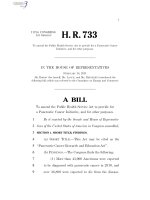Defense Base Act Insurance Allocating Wartime Contracting Risks Between Government and Private Industry
Bạn đang xem bản rút gọn của tài liệu. Xem và tải ngay bản đầy đủ của tài liệu tại đây (414.31 KB, 106 trang )
Defense Base Act Insurance:
Allocating Wartime Contracting Risks Between Government and
Private Industry
Hugh Barrett McClean*
*
Major Hugh B. McClean serves in the U.S. Air Force Judge
Advocate General’s Corps. The views expressed in this paper are
those of the author and do not reflect the official policy or
position of the United States Air Force, Department of Defense,
or the U.S. Government.
1
Table of Contents
I.Contractor Casualties — The Hidden Cost of War.........................................................................................3
A.Introduction.....................................................................................................................................3
B.Contractor Death Toll Exceeds That of U.S. Military in Iraq and Afghanistan................................8
C.Contractor Veterans Encounter Difficulties After Overseas Employment....................................13
II.Problems With The Current Regulatory Scheme........................................................................................21
A.The Longshore and Harbor Workers’ Compensation Act, the Defense Base Act, and the War
Hazard Compensation Act...................................................................................................22
B.DBA Insurance Concerns: Rising Costs and Denial of Claims........................................................30
III.Developing a New Acquisition Strategy.....................................................................................................52
A.Policy Changes Could Alleviate Existing Problems........................................................................52
B.Single-Provider Insurance Versus Open-Market Insurance: A 40 Year Debate............................58
IV.Acquisition Strategies.................................................................................................................................66
A.Maintaining the Current Open-Market System............................................................................66
B.Single-Provider System: An Impracticable Alternative.................................................................68
C.Multiple-Provider System: Taking Control of DBA Insurance.......................................................72
1.Privity of Contract.............................................................................................................73
2.Potential for Cost Savings.................................................................................................75
3.Competition......................................................................................................................77
4.Additional Protections for Contractors............................................................................78
5.Outcomes Versus Costs.....................................................................................................82
D.Maintaining the Status Quo...........................................................................................................86
E.Government Self-Insurance: An Ideal Alternative.........................................................................91
V.Conclusion: The Way Ahead......................................................................................................................100
2
I.
Contractor Casualties — The Hidden Cost of War
A.
Introduction
The killing of Osama Bin Laden has provided leverage to the
United States in the war against Al Qaeda, and some members of
Congress are now calling for a troop withdrawal and an end to
military operations in Afghanistan.1
However, the United States
invasion of Iraq invasion offers sound evidence that even if such
an order was given, the U.S. military, along with thousands of
civilian contractors, would remain in Afghanistan for some time.2
Long after the toppling of Saddam Hussein’s regime in 2003, U.S.
troops and civilian contractors remained in Iraq to begin the
massive undertaking of rebuilding infrastructure decimated by
years of war.3
continues.4
Now, eleven years later, the rebuilding of Iraq
Similar rebuilding efforts in Afghanistan are
already underway and will likely continue well into the future.5
1
See Siobhan Hughes, 27 Senators Call For Sizable Troop
Withdrawal From Afghanistan, Wall St. J., June 15, 2011,
/>2
Need citation See Michael Kamber, Iraq, THE NEW YORK TIMES,
available at />international/countriesandterritories/iraq/index.html.
3
Need citation See id.
4
Need citation See id.
5
Need citation See Afghanistan, THE NEW YORK TIMES, available at
/>itories/afghanistan/index.html.
3
Regardless of when U.S. soldiers withdraw from the Middle
East, senior military officialsthe United States has have pledged
their support to these veterans.6
Many injured soldiers have
been kept alive by improvements in Kevlar vests and other
lifesaving equipment, but are returning to the United States with
permanent disabling injuries.7
Other returning soldiers are
suffering from mental health disorders and pose a higher suicide
risk, a problem that has plagued the military during times of
lengthy and repeated troop deployments.8
Fortunately, universal
government health care for military members allows wounded
warriors to be treated by world-class physicians and health care
practitioners.9
However, there is a much lesser known contingent
of men and women working overseas in support of their military
brethren who are not as celebrated or as fortunate.
They are
America’s contractor veterans, and they, too, have suffered
injuries of war.
6
Need citation See e.g., Mission Statement, U.S. Dep’t of
Veterans Affairs, available at />_about.htm.
7
Need citation See e.g., Dan Froomkin, How Many U.S. Soldiers
Were Wounded in Iraq? Guess Again, THE HUFFINGTON POST available at
/>8
Need citation See Charles Hoge, Combat Duty in Iraq and
Afghanistan, Mental Health Problems, and Barriers to Care, 351
NEW ENGL. J. MED. 13, 14 (2004).
9
Need citation See Information on Veterans Health
Administration, U.S. Dep’t of Veterans Affairs, available at
/>4
Deployed contractors are returning home in record numbers
with many of the same injuries and health issues facing soldiers.
Working alongside the military, often in dangerous security
roles, contractor veterans are showing signs of post-traumatic
stress and other mental health disorders commonly found only in
soldiers exposed to combat.10
While a number of government
agencies are tasked with treating active duty and veterans of
U.S. wars, those same support networks are largely absent for
contractors.11 Regrettably, this issue has largely been ignored,
even as contractors and military members increasingly share the
same battle space.
This ignorance is partly due to an insolent
group of Americans who believe contractors are essentially
expendable.
12
They believe that the greatest benefit contractors
provide to the government is the expiration of their contract.13
However, injured contractors have recently been able to voice
their concerns to members of Congress, and government officials
10
Need citation See James Risen, After Iraq, Contractors Face
Mental Health Issues, N.Y. TIMES, Jul. 4, 2007,
/>11
Need citationId.
12
Need citation Aaron Walter, “Do Americans View Contractors in
Iraq as “Expendable Profiteers?” THE DEFENSE ACT BLOG (Mar. 7,
2008), />13
Need citationId.
5
are now beginning to debate the potentially broad and long-term
consequences of discounting these contractor veterans.
The issue parallels the national healthcare debate.
14
The
cost of treating the uninsured or underinsured in emergency rooms
has caused healthcare costs to skyrocket, but solutions for
increased coverage are costly and politically contentious.
15
Healthy Americans are arguably more productive and less
burdensome on healthcare and the economy, but opponents of
universal health care argue that the government cannot afford
health care for all Americans.16
The debate touches on the
fundamental question of whether the government has some kind of
moral obligation to care for those who cannot care for
themselves.
One might expect less of a debate on the issue of
whether the government has an obligation to contractor veterans
returning from war, as these Americans certainly draw more
sympathy from politicians.
However, much like the national
healthcare debate, Congress has been steadfastly focused on the
14
See After Injury, the Battle Begins: Evaluating Workers’
Compensation for Civilian Contractors in War Zones: Hearing
Before the H. Comm. on Oversight and Gov’t Reform, 111th Cong.
(2009), available at /> [hereinafter House Hearing on Defense Base Act].
15
See generally Patient Protection and Affordable Care Act, Pub.
L. 111-148, 124 Stat. 119 (codified as amended in scattered
sections of 42 U.S.C.).
16
Need citationJoe Messerli,”Should the Government Provide Free
Universal Healthcare to all Americans?” BALANCEDPOLITICS,
/>6
rising cost of the insurance that contractors use to protect
their employees.17
Rather than limiting reform efforts to fiscal matters, this
article calls upon Congress to capitalize on the opportunity to
correct substantive issues plaguing the Defense Base Act (DBA)18
insurance system.
Congress recently passed legislation requiring
the Secretary of Defense to adopt a new acquisition strategy for
insurance required by the DBA.19 While cost should be a
consideration of any new strategy for securing DBA insurance,
Congress must consider salient non-cost related benefits when
weighing the merits of various strategies.
20
Injured contractors
returning from Iraq and Afghanistan are being denied
reimbursement for medical treatment by their DBA insurance
carriers.21
The problem is occurring with even more frequency
when claims are filed by contractors who suffer from mental
illness related to combat stress.
22
Members of Congress have a
duty and an obligation to support contractor veterans and their
families, and they must fulfill that obligation when they choose
a new DBA acquisition strategy.
17
Need citation See House Hearing on Defense Base Act, supra note
14.
18
Defense Base Act, 42 U.S.C. §§§ 1651-1654 (2006).
19
See Duncan Hunter National Defense Authorization Act for Fiscal
Year 2009, Pub. L. No. 110-417 §843, 122 Stat. 4540 (2008).42
U.S.C. § 1655 (2008).
20
Need citation
21
Need citationHouse Hearing on Defense Base Act, supra note 14.
22
Need citation
7
This article is divided into four parts.
Part One describes
the problems encountered by injured contractors as they return
from war.
Part Two discusses how the regulatory scheme for
insuring contractors contributes to the problems experienced by
contractors.
Part Three offers practical suggestions for
Congress and the Department of Defense (DoD) as they prepare to
adopt a new DBA acquisition strategy.
Lastly, Part Four asserts
that the current open-market insurance strategy is inadequate and
argues that Congress should implement a multiple provider system
for DBA insurance.
In the short-term, a multiple-provider
strategy best addresses DBA insurance cost and claims processing
concerns, and can be implemented swiftly and without extensive
changes to the law.
However, Congress should begin taking steps
to implement government self-insurance, which offers even greater
savings and benefits for injured contractors.
B.
Contractor Death Toll Exceeds That of U.S. Military in
Iraq and Afghanistan
While the efforts of the men and women in uniform are often
publicly lauded, contractor contributions are frequently
overlooked.
Americans are well aware of the service members
whose lives have been lost in Iraq and Afghanistan but are well
insulated from the contractor death toll.
Contracting is the
primary means by which the U.S. military is able to complete its
mission without exceeding the personnel limitations imposed by
8
Congress.23
The current wars would not be sustainable relying on
these military members alone.
The military’s increased reliance on contractors in recent
wars has raised new issues regarding the treatment of injured
contractors returning from overseas.
Contractors have
historically been used to supplement the military by performing
tasks thatwhich DoD considers not “inherently governmental.”24
However, the line between what is and is not inherently
governmental is becoming increasingly blurred.
Non-inherent
government functions often include providing support to military
bases such as maintaining grounds, operating dining facilities,
and performing laundry services.25
However, DoD contractors also
provides security detail services, such as those provided by Xe
Services, formerly Blackwater Worldwide.26
In 2010, base support
and security services made up about 80% percent of the work
performed by DoD contractors in Iraq.27
Consequently, as
military resources are stretched thin by lengthy military
23
See Ike Skelton National Defense Authorization Act for Fiscal
Year 2011, Pub. L. No. 111-383, 124 Stat. 4137 (2011).
24
See FAR Subpart 7.5 (2011). Inherently governmental refers to
employment functions that are typically performed by military or
federal civilian employees rather than contract employees.
25
See MOSHE SCHWARTZ, CONG. RES. SERV., R40764, DEPARTMENT OF DEFENSE
CONTRACTORS IN IRAQ AND AFGHANISTAN: BACKGROUND AND ANALYSIS 8 (2010),
available at />26
See Mark Mazzetti and Emily B. Hager, Secret Desert Force
Setup By Blackwater’s Founder, N.Y. Times, May 14, 2011,
/>ref=blackwaterusa.
27
See Schwartz, supra note Error: Reference source not found, at
8.
9
operations on two fronts, the distinction between what is and is
not inherently governmental has become rather opaque.
The
contracting workforce has assumed many responsibilities not
previously performed by military members, including security
details.
Further, due to the number of contractors working in
hazardous duty locations,28 the risk to these contractors has
increased dramatically.
Now, the issue for the government is how
to manage the returning contractor workforce, which often suffers
from many of the same physical and mental maladies as military
veterans.
Professor Steven L. Schooner has written extensively on the
topic of contractor fatalities.29
His articles have unveiled
shocking statistics and brought much needed attention to the
dangers contractors face as they risk their lives to support the
military.
Between January and June of 2010, more military
contractors than uniformed service members were killed in
Afghanistan and Iraq.30
There were reportedly 250 contractor
28
Need citation
Steven L. Schooner is Co-Director of the Government Procurement
Law Program at the George Washington University Law School and
the Nash & Cibinic Professor of Government Contract Law. His
most recent publications on government contractor fatalities
include: Steven L. Schooner, Why Contractor Fatalities Matter,
PARAMETERS, Aug. 2008, at 78; Steven L. Schooner & Collin D. Swan,
Contractors and the Ultimate Sacrifice, SERV. CONTRACTOR., Sept.
2010, at 16; Steven L. Schooner & Collin D. Swan, Dead
Contractors: The Un-Examined Effect of Surrogates on the
Public’s Casualty Sensitivity, J. NAT’L SEC. LAW & POL’Y
(forthcoming 2011).
30
See Rogene Fisher Jacquette, Contractor Deaths in Iraq and
Afghanistan Outnumber Service Member Deaths, AT WAR: NOTES FROM THE
29
10
deaths and 235 military deaths during the six month period.31
Even more startling is that three times as many contractor
injuries were reported than military injuries since the beginning
of operations in Iraq in 2001.32
These statistics reflect an
upward trend in contingency contracting casualties, and the
contractor death toll is increasing exponentially compared to
military fatalities.
Between 2003 and 2010, contractor deaths
rose from five percent of the annual death toll to more than 50%
percent.33
As of March 2011, there were approximately 155,000
private contractors employed by the Department of Defense (DoD)
in Iraq and Afghanistan compared to 145,000 uniformed
personnel.34
Most surprisingly, contractors currently account
for approximately 52% percent of the workforce in Iraq and
Afghanistan35 and on average have outnumbered military personnel
FRONT LINES (Sept. 23, 2010, 2:27 PM),
/>scp=1&sq=contractor%20deaths%20outnumber&st=cse.
31
Need citation (probably same as previous)
32
See Steven L. Schooner & Collin D. Swan, Contractors and the
Ultimate Sacrifice, SERVICE CONTRACTOR, Sept. 2010, at 16, 17.
33
Id. at 17.
34
MOSHE SCHWARTZ, CONG. RES. SERV., R40764, DEPARTMENT OF DEFENSE
CONTRACTORS IN IRAQ AND AFGHANISTAN: BACKGROUND AND ANALYSIS (2011),
available at The
number of contractor and military personnel in Iraq and
Afghanistan has decreased from 207,600 contractors and 175,000
military since July 2010. Schwartz, supra note Error: Reference
source not found, at 8.
35
MOSHE SCHWARTZ, CONG. RES. SERV., R40764, DEPARTMENT OF DEFENSE
CONTRACTORS IN IRAQ AND AFGHANISTAN: BACKGROUND AND ANALYSIS (2011),
available at />11
in Afghanistan for the last two years.36
This support has
undoubtedly contributed to the success of the military, but the
reliance on contractors has come at a cost.
Professor Schooner’s articles have brought much needed
transparency to a quiet corner of government contracting.
Policy
makers and legislatures, as well as the general public, have
ignored the risks to contractors and have hardly raised an
eyebrow at the staggering trend in contractor fatalities.37
But
perhaps equally as troubling is the trend in contractor injuries,
which may have even further-reaching consequences.
Few
organizations have tracked injuries sustained by contractor
veterans, and even fewer have advocated for contractors or
provided support for their injuries.38
Insurance companies have
predominantly been responsible for employee injuries, but this
has only resulted in increased profits for carriers and excessive
denial of claims for injured workers.39
Given the limited number
of remedies under the current regulatory scheme, the Government
has not been able to limit costs or provide greater care for
contractors.
Thus, while contractors are dying in record
36
See James Glanz, Contractors Outnumber U.S. Troops in
Afghanistan, N.Y. Times, Sept. 1, 2009,
/>37
Need citation
38
Need citation
39
See infra part xxxxxx.
12
numbers, insurance carriers are seeing unprecedented increases in
revenue and profit.
C.
40
Contractor Veterans Encounter Difficulties After
Overseas Employment
The miracle of Kevlar has helped keep many contractors
alive.41
But, after sustaining traumatic injuries overseas,
injured contractors are faced with new challenges at home.42
In
most cases, family members are able to help manage their loved
ones’ illnesses, but filing claims for medical expenses and
dealing with insurance carriers can be a herculean task.43
Due
to the complex nature of mental health claims, such as those
related to post-traumatic stress disorder (PTSD) and traumatic
brain injury (TBI), the claims process for these cases can be
quite contentious.44
In fact, insurance carriers deny close to
40
See DEP’T OF DEF., OFFICE OF THE DEPUTY UNDER SEC’Y OF DEF. ACQUISITION
AND TECH., ACQUISITION STRATEGY FOR DEF.ENSE BASE ACT INSURANCE: REPORT TO
CONG. IN RESPONSE TO SECTION 843 OF THE NAT’L DEF. AUTHORIZATION ACT FOR
FISCAL YEAR 2009 i (2009), available at
/>t_insurance.pdf.
41
Steven L. Schooner & Collin D. Swan, Dead Contractors: The UnExamined Effect of Surrogates on the Public’s Casualty
Sensitivity, J. NAT’L SEC. LAW & POL’Y 14 (forthcoming 2011)
(citing Atul Gawande, Casualties of War – Military Care for the
Wounded from Iraq and Afghanistan, 351 NEW ENGL. J. MED. 2471,
2474 (2004), available at
/>42
Need citationSee Wounded Civilian Workers Fight For Care,
CBSNEWS.COM, (Jul. 27, 2009),
/>tml?tag=contentMain;contentBody
43
Need citation See id.
44
Need citation (probably same as next) See id.
13
half of all PTSD claims.45
For contractors and their families,
the process of appealing the denial of their claims, in addition
to managing the symptoms of their illnesses, is overwhelming.
Even more disturbing is that these illnesses are not welldocumented.
DoD did not even begin tracking data on contractors
in Iraq and Afghanistan until the latter half of 2007.46
It was
not until 2008 that DoD signed an agreement to use the
Synchronized Predeployment and Operational Tracker (SPOT) system,
a system designed to track contractor casualties.47
Before 2007,
the most accurate tally of contractor casualties was tracked by
the Department of Labor’s (DOL) Division of Longshore and Harbor
Worker Compensation, which tracks insurance claims submitted by
the family or employer of an injured or dead contractor.48
These
statistics provide critical quantitative data, which can be used
to estimate the actual cost of DoD operations, since DoD has
historically failed to account for contractor operations.49
While the implementation of SPOT has assisted the Government in
tracking contractor casualties, the Government Accountability
45
Wounded Civilian Workers Fight For Care, CBSNEWS.COM, (Jul. 27,
2009),
/>tml?tag=contentMain;contentBody. Id.
46
Schwartz, supra note Error: Reference source not found, at 4.
47
Schooner, supra note Error: Reference source not found, at 17.
48
Id.
49
Need citation See Schooner & Swan, supra note 41, at 19-20.
14
Office (GAO) and DoD concede that SPOT is still an inadequate
source of data.
Current research tracking the mental health of contractors
50
employed in war zones is even scarcer.
Studies conducted on
military populations suggest that contractors working in war
zones are probably suffering from the same mental health
disorders as military soldiers.
51
According to Dr. Matthew
Friedman, a Veterans Affairs official who heads the Nnational
Ccenter for Ppost-Ttraumatic Sstress Disordersyndrome, the issue
of mental illness in contractors has never been reviewed by the
Government.
52
Only recently have significant mental health
studies on military soldiers in Iraq and Afghanistan been
undertaken.
These studies have found that psychological
disorders may be disproportionately high when compared with
physical injuries from the two wars.53
The studies also show
that psychological disorders in the military community are often
50
See Schooner & Swan, supra note Error: Reference source not
found, at 27; See also Schwartz, supra note Error: Reference
source not found, at 4.
51
RAND CORP., INVISIBLE WOUNDS OF WAR: PSYCHOLOGICAL AND COGNITIVE
INJURIES, THEIR CONSEQUENCES, AND SERVICES TO ASSIST RECOVERY (Terri
Tanielian & Lisa H. Jaycox, eds., 2008), available at
/>720.pdf.
52
See James Risen, Back from Iraq, Contractors Face CombatRelated Stress: War Trauma Often Challenges Civilian Healthcare,
N.Y.TIMES, July 5, 2007, at A9; James Risen, After Iraq,
Contractors Face Mental Health Issues, N.Y.TIMES, July. 4, 2007,
available at
/>15
left untreated.54
In its 2008 study, the RAND Corporation found
that between 5five and 15%fifteen percent of deployed service
members are affected by PTSD.55
Another 2two to 14%fourteen
percent meet the diagnostic criteria for major depression.56
Of
the soldiers who screened positive for a mental health condition,
the study found that only one-third sought mental health support
while deployed.57
About the same number of soldiers who met
screening criteria for a mental health illness received mental
health support upon their return from deployment.58
The application of these findings to the contractor
community reveals a disturbing picture.
Contractor fatalities
recently surpassed military fatalities,59 suggesting contractors
are being exposed to many of the same hazards as military
members.
Given this statistic, it is reasonable to conclude that
there may be a large number of U.S. contractors who are in need
of mental health treatment.
This exposure likely includes many
second and third-tier subcontractors who are not as savvy or
sophisticated as prime contractors and are even less likely to
utilize DBA benefits.
53
See Terri Tanielian & Lisa H. Jaycox, eds., supra note Error:
Reference source not found.
54
Id. at 251.
55
Id. at iii.
56
Id. at 250.
57
Need citation (likely same source)
58
Id. at 251.
59
Need citation (probably the same as fn. 31)
16
One contractor found that a significant percentage of his
employees were not receiving needed mental health care.
60
Paul
Brand, a psychologist and Chief Executive Officer of the firm
Mission Critical Psychological Services (MCPS), L.L.C.,
61
independently conducted a study on contractors’ mental health
while working at DynCorp, the Department of State’s (DOS) largest
contractor.
He found that 24%twenty-four percent of contract
employees from DynCorp had symptoms of PTSD or depression after
their overseas employment.
62
He also found that many of the
60
See T. Christian Miller, Civilian Contractors: The Uncounted
Casualties of War, STAR LEDGER, Feb. 28, 2010, at 7; T. Christian
Miller, The Other Victims of Battlefield Stress: Defense
Contractors’ Mental Health Neglected, PROPUBLICA.ORG, (Feb. 26,
2010, 2:48 AM), available at
/>61
Paul Brand, Ph.D., founded MCPS to offer psychological
screening and services for people working in war-torn areas.
Before starting MCPS, as the president of Medina & Thompson,
Inc., Dr. Brand developed psychological fitness programs to
support police officers sent to Haiti, Bosnia, Kosovo, Israel,
Liberia, and East Timor as part of peacekeeping initiatives. Dr.
Brand also helped DynCorp International, the Department of
State's largest contractor, become the first company with
comprehensive psychological support for its employees serving in
Iraq and Afghanistan. Dr. Brand holds his Ph.D. in Psychology
from the Illinois Institute of Technology and has lived and
worked in Kosovo, Afghanistan and Iraq, as well as the United
States. About Us, MISSION CRITICAL PSYCHOLOGICAL SERVICES, LLC,
/>//www.missioncriticalpsych.com/ (last visited July. 7, 2011).
62
Miller, Civilian Contractors: The Uncounted Casualties of War,
supra note Error: Reference source not found; Miller, The Other
Victims of Battlefield Stress: Defense Contractors’ Mental
Health Neglected, supra note 60. As previously mentioned, RAND
Corp. reported that 5five to 15%fifteen percent of military
members reported symptoms of PTSD and 2two to 14%fourteen percent
met the criteria for major depression. See Tanielian & Jaycox,
17
contractors had never received mental health screening and were
not receiving treatment for their symptoms.63
Based on his
study, he estimated that thousands more contractors employed by
other firms were probably not being screened or receiving
treatment of any type.64
The importance of these findings lies in the relationship
between mental health and suicide.
Researchers have long
believed that mental health and suicide are closely related.65
As senior military officials struggle to balance troop
deployments with fluctuating financial constraints, they remain
highly cognizant of the long-standing concern about suicide among
military personnel.
66
Studies show that the majority of persons
who have committed suicide suffered from at least one mental
disorder.67
Reducing suicide incidents, which is experiencing
renewed importance in the military, is therefore dependent upon
obtaining treatment for soldiers and contractors who are in need
of mental health care.
The fast-paced operations tempo and the duration of recent
wars have caused a rise in suicide among military personnel, a
eds.RAND CORP., supra note Error: Reference source not found, at
250. These statistics suggest that perhaps a higher percentage
of contractors are suffering from mental health problems than
military members.
63
Need citation (probably previous source)
64
Need citation (same as last)
65
See Terri Tanielian & Lisa H. Jaycox, eds., supra note Error:
Reference source not found, at 128.
66
See id. Need citation
67
Id.
18
situation thatwhich has caught DoD by surprise.
68
Between 2005
and 2009, 1,100 military members took their lives,; the
equivalent of one member every 36 hours.69
The suicide rate in
all services has increased since 2001, but the rate in the Army
has more than doubled.70
Among Army personnel, the suicide rate
has exceeded that of the civilian population since 2005.71
The
rising suicide rates shocked military leaders and congressional
leaders to such an extent that when Congress passed the Duncan
Hunter National Defense Authorization Act for Fiscal Year 2009
(NDAA for 2009), they directed the Secretary of Defense to
establish a task force to examine matters related to suicide
prevention in the Armed Forces.
72
The Secretary of DefenseDoD
task force submitted the task force’sa detailed suicide report to
the Committees on Armed Services of the Senate and House of
Representatives in August, 2010.73
They made 49 findings and 76
68
DEPARTMENT OF DEFENSE TASK FORCE ON THE PREVENTION OF SUICIDE BY MEMBERS
OF THE ARMED FORCES, THE CHALLENGE AND THE PROMISE: STRENGTHENING THE FORCE,
PREVENTING SUICIDE AND SAVING LIVES, AUGUST 2010, 107 (Aug. 2010),
available at />%20Prevention%20Task%20Force%20report%2008-21-10_V4_RLN.pdf.
69
Id. at ES-1.
70
DEPARTMENT OF DEFENSE TASK FORCE ON THE PREVENTION OF SUICIDE BY MEMBERS
OF THE ARMED FORCES, THE CHALLENGE AND THE PROMISE: STRENGTHENING THE FORCE,
PREVENTING SUICIDE AND SAVING LIVES, AUGUST 2010, supra note 68Id. at
ES-1 to ES-2.
71
Id. at 175.
72
See Duncan Hunter National Defense Authorization Act for Fiscal
Year 2009, Pub. L. No. 110-417 §843733, 122 Stat. 4540 (2008).
73
DEPARTMENT OF DEFENSE TASK FORCE ON THE PREVENTION OF SUICIDE BY MEMBERS
OF THE ARMED FORCES, THE CHALLENGE AND THE PROMISE: STRENGTHENING THE FORCE,
PREVENTING SUICIDE AND SAVING LIVES, AUGUST 2010, supra note Error:
Reference source not found, at A-3.Need citation (likely same as
19
recommendations across four focus areas.74
While the task force
found that military policy on the delivery of mental health care
to the Armed Forces is well-intended, it concluded that the
system is unorganized and lacking in mental health professionals
and other necessary resources.75
The renewed focus on mental health in the military is a
positive sign that DoD is finally addressing this critical need
of its warfighters.
The focus will undoubtedly improve the
overall effectiveness of the U.S. military.
However, none of the strategies cited in the DoD study and
almost none of DoD’s resources will be dedicated to helping U.S.
contractors in their fight against mental illness.
Contractors
working alongside the U.S. military are experiencing combat
stress and battle-fatigue but are off the radar and out of the
scope of DoD officials.76
Unlike the military, there is no
support network in place to help injured contractors cope with
the stress of their injuries or navigate the medical claims
fn. 75)
74
Id. at v.Need citation (likely same as fn. 75)
75
DEPARTMENT OF DEFENSE TASK FORCE ON THE PREVENTION OF SUICIDE BY MEMBERS
OF THE ARMED FORCES, AUGUST 2010, supra note Error: Reference source
not found, at ES-2, ES-6.
76
See T. Christian Miller, Civilian Contractors: The Uncounted
Casualties of War, STAR LEDGER, Feb. 28, 2010, at 7; T. Christian
Miller, The Other Victims of Battlefield Stress: Defense
Contractors’ Mental Health Neglected, PROPUBLICA.ORG, (Feb. 26,
2010, 2:48 AM), />citation
20
process.
Without the necessary support and resources,
77
contractors are left to fight the symptoms of their illnesses on
their own.
78
II.
Problems With The Current Regulatory Scheme
77
Advocacy or support for wounded contractors has been limited to
volunteer providers. Jana Crowder, who operates a website
dedicated to injured contractors, is one such provider. She is
the organizer of a Tennessee support group for injured
contractors, and, though not a health professional, has helped
injured contractor veterans returning from Iraq. See Day to
Day: Iraq Contractors Convene in Tennessee, NATIONAL PUBLIC RADIO
(Feb. 12, 2007), />storyId=7364190. Crowder’s website is available at CIVILIAN
CONTRACTORS IN IRAQ & AFGHANISTANAMERICAN CONTRACTORS IN IRAQ,
(last visited July. 8,
2011).
78
Beginning in 2007, three media outlets, The Los Angeles Times,
ABC News, and ProPublica, began reporting on the tribulations of
injured contractors returning from Iraq and Afghanistan. The
stories of these injured contractors are disturbing. One
contractor, Preston Wheeler, was a truck driver employed by
Kellog, Brown, and Root (KBR) in Iraq, who witnessed the murder
of his co-worker in 2005. It took Mr. Preston two years to find
a support group in which he could begin to confront his emotional
problems. Another KBR employee, Robert Rho, was also injured in
Iraq and fought with his insurance carrier over benefits for
years after his return. A third KBR contractor had to bring his
case to the attention of Tennessee Senator Lamar Alexander before
receiving his DBA entitlements. See Day to Day: Iraq
Contractors Convene in Tennessee, supra note 77. However, the
most horrific example of exploiting contractor veterans and their
families is the case of Wade Dill. Mr. Dill accepted a job in
Afghanistan performing pest extermination services to help pay
for his daughter’s college education. On one occasion Mr. Dill
was called to clean up the remains of a young soldier who had
shot himself in the head. The task had such a profound and
disabling effect on Mr. Dill that eventually Mr. Dill quit his
job and separated from his wife. On July 16, 2006, Mr. Dill was
found dead in a local hotel room a few miles from their home. He
had left a note, which read “I did exist and I loved you.” His
21
A.
The Longshore and Harbor Workers’ Compensation Act, the
Defense Base Act, and the War Hazard Compensation Act
Congress is now debating alternatives to the regulatory
scheme that protects contractors overseas,79 but the merits of
these alternatives must be weighed against current regulations.
The Government provides workers’ compensation benefits to various
wife, Barbara Dill, filed a claim with KBR’s insurance provider,
AIG, claiming her husband’s death was a result of PTSD brought on
by his employment in Iraq. Her expert witness Dr. Seaman, who
specialized in PTSD, concluded that “[t]he bottom line is that
the combination of physical separation and work-related stress
resulted in increasingly emotional distance, greater distortion
of the relationship, increasing emotional intensity, and a
pattern of increasing erratic behaviors that culminated in
suicide . . . .”Three experts offered opinions on the issue, and
all agreed that Mr. Dill suffered from PTSD. However, the expert
for AIG believed the illness was caused by marital and family
problems, and believed it was unrelated to the stresses of his
employment in Iraq. The DOL recommended AIG pay the claim, but
AIG refused. Ms. Dill’s only recourse was to file an appeal
through DOL’s dispute resolution system, a process thatwhich
tookcan take months or even years to complete. See T. Christian
Miller, The War’s Quiet Scandal, The Daily Beast, Feb. 25, 2010,
www.thedailybeast.com/blogs-and-stories/2010-02-25/the-warsquiet-scandal/full. She eventually won her appeal in 2011, five
years after her husband’s death. See Day to Day: Iraq
Contractors Convene in Tennessee, National Public Radio (Feb. 12,
2007), />storyId=7364190; See also T. Christian Miller, The War’s Quiet
Scandal, The Daily Beast, Feb. 25, 2010,
www.thedailybeast.com/blogs-and-stories/2010-02-25/the-warsquiet-scandal/full. For death benefit award decision, sSee Dill
v. Serv. Emps. Int’l, Inc.ALJ’s Decision and Order, Barbara Dill,
Case No. 2008-LDA-00259, 43-44 (Dep’t of Labor Jan. 21, 2011),
available at
/>SERVICE_EMPLOYEES_IN_2008LDA00259_
%28JAN_21_2011%29_134436_CADEC_SD.pdf.
79
See After Injury, the Battle Begins: Evaluating Workers’
Compensation for Civilian Contractors in War Zones: Hearing
Before the H. Comm. on Oversight and Gov’t Reform, 111th Cong. 19
(2009) (statement of Seth D. Harris, Deputy Secretary, Department
of Labor), available at />
categories of employees who perform work for the Government.80
In some cases, the Government provides these benefits directly,
with funds appropriated by Congress.81
In other cases, the
Government mandates that contractors provide these benefits to
their employees.82
Benefits are generally distributed based on
one of four employee types: military, civil service, nonappropriated fund instrumentality (NFI), and contractor
employees.83
All members of the U.S. military are eligible to receive pay
and benefits, including pay and benefits for injuries, medical
expenses, and life insurance coverage.84
Almost any injury or
death of a military member while in active status entitles the
member to benefits, regardless of whether the member was
performing military duties when he or she wasthey were injured or
killed.85
Funding for military benefits is provided through
bin/getdoc.cgi?dbname=111_house_hearings&docid=f:65546.pdf.Need
citation
80
See History of OWCP, U.S. DEPARTMENT OF LABOR, OFFICE OF WORKERS’
COMPENSATION PROGRAMS, (last
visited Jan. 14, 2012) (discussing various workers’ compensation
programs administered by Federal Government).Need citation
81
See, e.g., Federal Employees Workers’ Compensation Act, 5
U.S.C. § 8102(a) (2006).Need citation
82
See, e.g., Longshore and Harbor Workers’ Compensation Act, 33
U.S.C. § 904 (2006).Need citation
83
Need citation See 5 U.S.C. § 8101 (2006) (civil service); 5
U.S.C. § 8171(a) (2006) (NFI); 42 U.S.C. § 1651(a) (2006)
(military and contractor employees).
84
See 10 U.S.C. $ 1074(a)(1) (2006).
85
See 10 U.S.C. § 1074(a)(2) (2006).
23
congressional appropriations to DoD, which oversees the Military
Health System (MHS).86
Civilian employees, or “civil servants,” are directly
employed by the Government and receive compensation for workrelated injuries under Title 5, Chapter 81, of the United States
Code.87
The Federal Employees’ Compensation Act (FECA) provides
funding for the benefits received by civil servants covered by
the statute.88
The benefits are comprehensive and cover
compensation for disability and death of employees,89 death
gratuities for injuries in connection with an employee’s service
with an Armed Force,90 and medical services.
Compensation for injuries or death for NFI employees and
contractors is not directly paid for by appropriated funds.
Rather, through various amendments, Congress has directed that
NFIs and contractors provide benefits granted under the Longshore
and Harbor Workers’ Compensation Act (LHWCA) to their
employees.91
The LHWCA was enacted in 1927 and is administered
86
See RICHARD A. BEST, JR., CONG. RRESEARCH SSERV., IB93103, MILITARY
MEDICAL CARE SERVICES: QQUESTIONS AND AANSWERS (2005), available at
/>87
See Compensation for Work Injuries, 5 U.S.C. §§ 8101-8152
(2006).
88
This U.S. Treasury fund is a collection point for
appropriations made by Congress for the purpose of paying
compensation and other benefits and expenses to eligible federal
employees. See U.S. DEPARTMENT OF LABOR, DIVISION OF FEDERAL EMPLOYEES’
COMPENSATION, PROCEDURAL MANUAL, available at
/>89
5 U.S.C. § 8102 (2006).
90
5 U.S.C. § 8102(a) (2006).
91
See Longshore and Harbor Workers’ Compensation Act, 33 U.S.C.
§§ 901-950 (2006).
24
by the Office of Workers’ Compensation Programs (OWCP), under the
DOL.92
As the title of the statute suggests, the LHWCA was
originally intended to provide compensation for the disability or
death of a maritime employee if the disability or death arose
from an injury occurring upon the navigable waters of the United
States.93
However, through various amendments, the Government
has used the LHWCA to provide coverage to workers engaged in a
wide- range of public works projects.94
The statute requires
employers to provide coverage for qualifying employees who are
performing work for the Government in certain areas.95
The LHWCA contains benefits for many specific contingencies.
Benefits include medical services, supplies, and even choice of
physician.96
The statute also provides for disability and death
benefits, depending on whether an injury is permanent or
temporary and whether the worker is partially or totally
disabled.97
Typically, injured workers receive two-thirds of
their average weekly wages for the duration of their
92
Division of Longshore and Harbor Workers' Compensation, DOL.GOV,
(last visited Jan.
23, 2011).
93
33 U.S.C. § 903 (2006).
94
Need citation
95
See Longshore and Harbor Workers’ Compensation Act, § 904.
96
Longshore and Harbor Workers’ Compensation Act § 907(a)-(b).
97
Longshore and Harbor Workers’ Compensation Act § 908. Specific
injuries are listed with particularity in the statute, such as:
“Compensation for loss of more than one phalange of a digit shall
be the same as for loss of the entire digit. Compensation for
loss of the first phalange shall be one-half of the compensation
for loss of the entire digit.”
25









